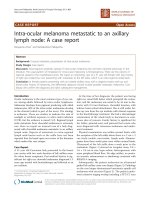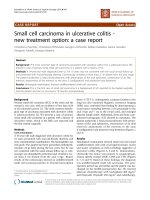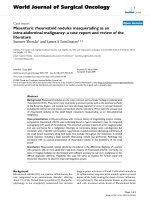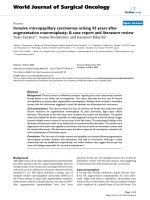báo cáo khoa học: " Paradoxical embolism following thromboaspiration of an arteriovenous fistula thrombosis: a case report" pot
Bạn đang xem bản rút gọn của tài liệu. Xem và tải ngay bản đầy đủ của tài liệu tại đây (1.6 MB, 5 trang )
CAS E REP O R T Open Access
Paradoxical embolism following thromboaspiration
of an arteriovenous fistula thrombosis: a case report
Bouteina Bentaarit
1
, Anne Marie Duval
2
, Anne Maraval
3
, Djamal Dahmane
1
, Karine Dahan
1
, Brahim Amara
1
,
Philippe Lang
1
, Djillali Sahali
1*
Abstract
Introduction: Paradoxical embolism is an increasingly reported cause of arterial embolism. Several embolic sources
have been described, but thrombosis of an arteriovenous fistula as a paradoxical emboligenic source has not, to
the best of our knowledge, been reported.
Case presentation: A 50-year-old Caucasian woman received a renal graft for primary hyperoxaluria. After
transplantation, she was maintained on daily hemodialysis. Thrombosis of her arteriovenous fistula occurred two
weeks post-transplantation and was treated by thromboaspiration, which was partially successful. During a
hemodialysis session immediately following thromboaspiration, she developed a coma with tetraplegia requiring
intensive cardiorespiratory resuscitation. Brain magnetic resonance imaging revealed various hyperdense areas in
the vertebrobasilar territory resulting from bilateral occlusion of posterior cerebral arteries. Transesophageal
echocardiographic examination showed a patent foramen ovale, while pulse echography of the arteriovenous
fistula revealed the persistence of extensive clots that were probably the embolic source. A paradoxical embolus
through a patent foramen ovale was suggested because of the proximity of the neurological event to the
thrombectomy procedure.
Conclusions: The risk of paradoxical embolism in a hemodialyzed patient with a patent foramen ovale deserves
consideration and requires careful evaluation in situations of arteriovenous fistula thrombosis.
Introduction
The foramen ovale is usually obliterated following the
establishment of adult circulat ion, but remains patent in
25% of individuals [1]. This potential communication
between the venous and arterial circulation can allow
thromboembolic material to bypass the lungs and enter
the systemic circulation. Paradoxical embolism occurs
when a thrombus from the venous circulation passes
into the arterial circulation through an intracardiac or
vascular defect. We describe a case of paradoxical
embolization through a patent foramen ovale (PFO) fol-
lowing thromboaspiration for acute thrombosis of an
arteriovenous (AV) fistula. Although the risk of pulmon-
ary embolism in this setting is well documented [2], to
the best of our knowledge, no paradoxical embolism
after thromboaspiration has been reported.
Case presentation
A 50-year-old Caucasian wom an was admitted for kid-
ney transplantation. Renal history began at 10 years of
age when she was hos pitalized for several episodes of
ureteral colic due to recurrent stone disease. She was
married with four children. During each pre gnancy, she
was treated for hypertension. At 40 years of age, she
was evaluated for severe ar terial hypertension. Investiga-
tions revealed proteinuri a (2 gr/24 h) and an increase in
plasma creatinine (12 μmol/dL). Renal ultrasound
showed multiple stones in theleftkidneyandbladder,
while the right kidney was atrophied. The diagnosis of
primary hyperoxaluria type I was established by the
detection of the G170R mutation in the peroxisomal
alanine-glyoxylate aminotransferase (AGT) gene. The
residual activity of AGT was less than 28% in biopsied
liver tissue from our patient. As chronic renal failure
progressed, our patient experienced, at 44 years of age,
multiple embolic episodes involving the femoral arteries,
hypogastric arteries, splenic artery and renal arteries,
* Correspondence:
1
Service de Néphrologie, AP-HP, Groupe hospitalier Henri Mondor - Albert
Chenevier, Créteil, F-94010 France
Full list of author information is available at the end of the article
Bentaarit et al. Journal of Medical Case Reports 2010, 4:345
/>JOURNAL OF MEDICAL
CASE REPORTS
© 2010 Bentaarit et al; licensee BioMed Central Ltd. This is an Open Access ar ticle distributed under the terms of the Creative
Commons Attribution License (ht tp://creative commons.org/licenses/by/2.0), which permits unrestricted use, distribution, and
reproduction in any medium, provided the original work is properly cited.
and requiring surgical thrombectomy. Transthoracic
echocardiography revealed an intraventricular thromb us
associated with hypokinesia of the apical region and the
interventricular septum. Hematological studies including
tests for thrombophilia (protein C and protein S defi-
ciency, factor V Leiden, anti-thrombin III deficiency,
and anti-phospholipid antibody syndrome) and serum
homocysteine conc entrations yielded normal results. An
electrocardiogram did not reveal an y signs of atrial
fibrillation or myocardial infarction.
Our patient was d ischarged with long-term treatment
with anti-vitamin K. Terminal renal failure was precipi-
tated by bila teral renal artery embolism requiring the
initiation of hemodialysis, which was performed five days
per week because of hy peroxaluria. Kidney transplanta-
tion was performed two years foll owing the initiation of
dialysis, but the graft was rapidly lost at day seven post-
transplantation, secondary to throm bosis of the graft
vein. Our patient was maintained on periodic hemodialy-
sis for four years, after which she rece ived a second renal
transplantation from a cadav eric donor. The immediate
course was marked by delayed graft function allowing the
deferred use of calcineurin inhibitors. The immunosup-
pressive regimen consisted of anti-thymocyte globulin
(ATG) and methylprednisolone therapies. Heparin ther-
apy was started 12 hours following the surgical proce-
dure. A kidney biopsy on day 14 post-transplantation
revealed the presence of calcium oxalate crystals in the
parenchyma, which led to the start of daily dialys is using
a large surface membrane. Diuresis progressively recov-
ered from day 18 post-transplantation but dialysis was
continued. On day 22, our patient developed major
bleeding with acute anemia, requiring blood transfusion
and the termination o f heparin therapy. A non-infusion
computed tomography (CT) scan of the abdomen
revealed a perigraft hematoma. Three days later (on day
25), she developed thrombo sis of her AV fistula. Ant i-
coagulation treatment with danaparoid sodium (Orgaran)
was reinitiated. A tunneled silicone catheter was inserted
in the right femoral vein. A revascularization procedure
by angioplasty and stent deployment was attempted five
days later. A 6 French vascular sheath was placed
upstream of the occluded venous arm of the fistula, then
replaced by a 9 Fren ch vascular sheath to in crease the
lumen of the occluded vein, after which a 6 French cathe-
ter was used to aspirate the clots. However, alt hough th e
fistula was only partially repermeabilized on the side of
the venous anastomosis, it was immediately reused for
hemodialysis. While our patient was alert and her status
was normal on initiation of th e dialysis session (Glasgow
Coma Scale 15), three hours later she developed diffuse
seizures and became rapidly unresponsive (Glasgow
Coma Scale 3), prompting intubation for airway protec-
tion. Magnetic resonance imaging showed multiple areas
of increased density representing severe ischemia in the
vertebrobasilar territory, which result from bilateral
occlusion of posterior cerebral arteries (Figure 1).
Our patient was managed in our intensive care depart-
ment. Transesophageal echocardiography (TEE) per-
formed two months later revealed a previously unknown
PFO with a left-to-right shunt at the interatrial septum
(Figu re 2). However, contrast echocardiography test was
not performed because of the absence of permeable per-
ipheral veins in our patient. The TEE examination did
not reveal other embolic sources in the ascending aorta
and aortic arch.
Our patient was discharged from the intensive care
department with stable renal functi on (serum creatinine
at 15 μmol/dL) two months after admission. The serum
oxalate concentration was 2.15 μmol/dL (normal: below
33 μmol/dL). Neurological evaluation six months after
the stroke showed the persistence of weakness predomi-
nantly in the inferior limbs, as well as dysarthria, antero-
grade amnesia and hyperemotivity.
Discussion
The number of patients maintained on periodic hemo-
dialysis is increasing due to the improvement of the
long term survival of this patient population and
because of an exponential increase of diabetic kidney
disease. Currently, the management of AV fistula
thrombosis is essentially based on thromboaspiration
performed by an interventional radiologist. This techni-
que is commonly endowed with a high rate of success
and a low rate of complications [3].
Pulmonary embolisms as well as fatal paradoxical
embolism of the brain after percutaneous thrombolysis
of a hemodialysis graft have been reported [2]. These
comp lications remain rare, as shown by the finding that
in a large series totaling 1460 cases treated by mechani-
cal thrombolysis, no symptomati c pulmonary or sys-
temic embolisms occurred [4]. Nonetheless, the
morbidity and mortality rates are more significant in
patients with paradoxical embolism [2].
The cli nical diagnosis of paradoxical embolism
requires the presence of deep venous thrombosis and/or
pulmonary embolism, an intracardiac defect w ith a
right-to-left shunt, associated with the absence of an
emboligenic source in the left side of the heart. In our
patient, the timing of the paradoxical embolism, which
occurred after a thromboaspiration procedure for AV
fistula thrombosis, the absence of an arterial emboli-
genic source and the documentat ion of a PFO with left-
to-right shunt by TEE stronglysuggestthatthebrain
emboli arose from the thrombosed AV fistula. The
severity of the paradoxical embolism made it impossible
to perform contrast or bubble echocardiography to
visualize the inversion of the shunt in the early phase of
Bentaarit et al. Journal of Medical Case Reports 2010, 4:345
/>Page 2 of 5
Figure 1 Acute vertebrobasilar territory stroke following percutaneous thromboaspiration of an occluded arteriovenous fistula of the
forearm. (A) Magnetic resonance imaging (MRI) of the head. Serial 5 mm axial brain images show the presence of bilateral hypersignal areas
(indicated by arrowheads) in the cerebellar hemispheres and bulboprotuberancial junction. (B) Hypersignal in the thalamic areas, predominantly
on the left. (C) Hypersignal in the occipital lobe. (D) Polygon of Willis by MRI time of flight show bilateral occlusion of the posterior cerebral
arteries. (E) Polygon configuration of Willis in our patient. The arrows show the localization of bilateral occlusion of the Posterior cerebral arteries
(PcoA, posterior communicating artery; PCA, posterior cerebral artery (P1 and P2 indicate the PCA segments); ACA, anterior cerebral artery (A1
+A2 indicate the ACA segments); MCA, middle cerebral artery; ICA, internal carotid artery; BA, basilar artery; VA, vertebral artery. Note that our
patient displays a “fetal type” right PCoA, in that the P1 segment is hypoplastic and the ICA supplies right posterior cerebral territory via PCoA.
Bentaarit et al. Journal of Medical Case Reports 2010, 4:345
/>Page 3 of 5
the stroke. Paradoxical embolism results from the inver-
sion of the shunt, caused by an acute increase in right
atrial pressure, in our case a possible direct consequence
of the thromboaspiration procedure through venous
migration of the clots or hemodynamic cha nges. When
right atrial pressure exceeds that of the left, the inver-
sion of the shunt (right-to-left) occurs through the PFO.
More rarely, an acute elevation of right atrial pressure
can occur in the settin g of chronic pulmonary heart dis-
ease or Valsalva maneuver. In our pa tient, pulse echo-
graphy did not detect any vein thrombosis, except that
of the AV fistula. Paradoxical embolism is frequently
associated with pulmonary embolism, which is a com-
mon cause of increased right atrial pressure.
Given that the prevalence of PFO is 25% in the gen-
eral population, the possibility of a paradoxical embo-
lism must be suspected in patients who p resent with
arterial embolism without a clearly identified cause such
as atrial fibrillation, carotid artery stenosis or cholesterol
embolism. A PFO has been diagnosed in 50% of patients
with stroke compared with 15% of co ntrol subjects [5].
The most frequent sites of paradoxical embolism are the
extremities (50%) and the brain (40%), while the heart,
spleen and kidney are more rarely affected [6].
In this case, multiple emboli occurring while our
patient displayed moderate renal failure probably arose
from the intraventricular thrombus revealed by trans-
thoracic echocardiography. In retrospect, it is possible
that this mural thrombus may have masked a pre-exist-
ing PFO. A paradoxical embolism revealing a vermicular
thrombus trapped in the PFO with floating parts in the
right and left atrium, complicating a deep-vein thrombo-
sis of the right superficial femoral vein, has recently
been reported in an 85-year-old woman [7]. Paradoxical
embolism involving multiple organs has also been
reported [8].
The diagnosis of PFO is best accomplished by contrast
or bubble TEE because it more accurately reveals PFOs
with a right-to-left atrial shunt. Its sensitivity and its
specificity approach 96% [9].
The treat ment of paradoxical embolism includes anti-
platelet agents, systemic anticoagulation and closure of
the PFO [10]. In its acute phase, paradoxical embolism
is usually treated by thrombolytic and heparin therapy,
followed by anti-vitamin-K therapy, which should be
continued for three to six months. Anti-vitamin-K ther-
apy should be continued indefinitely in the f ollowing
situations: (i) recurrent paradoxical embolism; (ii)
Figure 2 Transesophageal echocardiography. A patent foramen ovale (PFO) with a left-to-right shunt is shown at the level of the interatrial
septum. RA and LA indicate right and left atria.
Bentaarit et al. Journal of Medical Case Reports 2010, 4:345
/>Page 4 of 5
persistent PFO; (iii) chronic obstructive pulmonary dis-
ease-induced pulmonary hypertension that leads to
increased right atrial pressure and shunting through the
PFO. Given the prevalence of PFO in the general popu-
lation, closure is indicated only in some pathological
situations such as recurrent paradoxical embolism or
when systemic anti-coagulation is contraindicated. Clo-
sure can be accomplished by percutaneous o r surgical
methods.
Conclusions
The severity and potential fatal outcome of paradoxical
embolism raises the question of PFO screening in
patients treated by hemodialysis. When a patient with a
PFO with a known right-to-left shunt develops throm-
bosis of an AV fistula, it is advisable for the interven-
tional radiologist and the surgeon to choose the
technique that presents the lowest risk of embolization,
while informing the patient of the potential risk.
Consent
Written informed consent was obtained from the patient
for publication of this case report and any accompany-
ing images. A copy of the written consent is available
for review by the journal’s Editor-in-Chief.
Author details
1
Service de Néphrologie, AP-HP, Groupe hospitalier Henri Mondor - Albert
Chenevier, Créteil, F-94010 France.
2
Service de neuroradiologie, AP-HP,
Groupe hospitalier Henri Mondor - Albert Chenevier, Créteil, F-94010 France.
3
Service de cardiologie, AP-HP, Groupe hospitalier Henri Mondor - Albert
Chenevier, Créteil, F-94010 France.
Authors’ contributions
BB, AMD, AM, DD, KD and BA managed the patient in their respective
departments and contribute to the preparation of this case report. PL is the
supervisor of the management and DS has managed the patient and
written this case report. All authors read and approved the final manuscript.
Competing interests
The authors declare that they have no competing interests.
Received: 24 October 2009 Accepted: 28 October 2010
Published: 28 October 2010
References
1. Desai AJ, Fuller CJ, Jesurum JT, Reisman M: Patent foramen ovale and
cerebrovascular diseases. Nat Clin Pract Cardiovasc Med 2006, 3:446-455.
2. Briefel GR, Regan F, Petronis JD: Cerebral embolism after mechanical
thrombolysis of a clotted hemodialysis access. Am J Kidney Dis 1999,
34:341-343.
3. Bush RL, Lin PH, Lumsden AB: Management of thrombosed dialysis
access: thrombectomy versus thrombolysis. Semin Vasc Surg 2004,
17:32-39.
4. Beathard GA, Welch BR, Maidment HJ: Mechanical thrombolysis for the
treatment of thrombosed hemodialysis access grafts. Radiology 1996,
200:711-716.
5. Webster MW, Chancellor AM, Smith HJ, Swift DL, Sharpe DN, Bass NM,
Glasgow GL: Patent foramen ovale in young stroke patients. Lancet 1988,
2:11-12.
6. Gill TJ, Campbell CC: Radial artery occlusion by a paradoxical embolism: a
case report. J Hand Surg [Am] 1995, 20:406-407.
7. Dorr M, Hummel A: Images in clinical medicine. Paradoxical embolism–
thrombus in a patent foramen ovale. N Engl J Med 2007, 357:2285.
8. Turedi S, Gunduz A, Eroglu O, Hos G, Durmus I, Gokce M, Bulbul Y:
Paradoxical embolism involving 4 organ systems (pulmonary, renal,
splenic, and hepatic artery). Am J Emerg Med 2007, 25:e731-733.
9. Chen WJ, Kuan P, Lien WP, Lin FY: Detection of patent foramen ovale by
contrast transesophageal echocardiography. Chest 1992, 101:1515-1520.
10. Nendaz M, Sarasin FP, Bogousslavsky J: How to prevent stroke recurrence
in patients with patent foramen ovale: anticoagulants, antiaggregants,
foramen closure, or nothing? Eur Neurol 1997, 37:199-204.
doi:10.1186/1752-1947-4-345
Cite this article as: Bentaarit et al.: Paradoxical embolism following
thromboaspiration of an arteriovenous fistula thrombosis: a case report.
Journal of Medical Case Reports 2010 4:345.
Submit your next manuscript to BioMed Central
and take full advantage of:
• Convenient online submission
• Thorough peer review
• No space constraints or color figure charges
• Immediate publication on acceptance
• Inclusion in PubMed, CAS, Scopus and Google Scholar
• Research which is freely available for redistribution
Submit your manuscript at
www.biomedcentral.com/submit
Bentaarit et al. Journal of Medical Case Reports 2010, 4:345
/>Page 5 of 5









